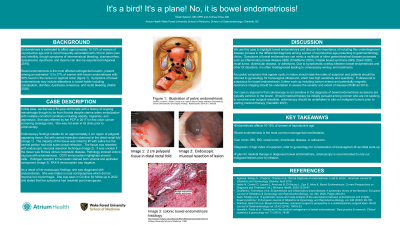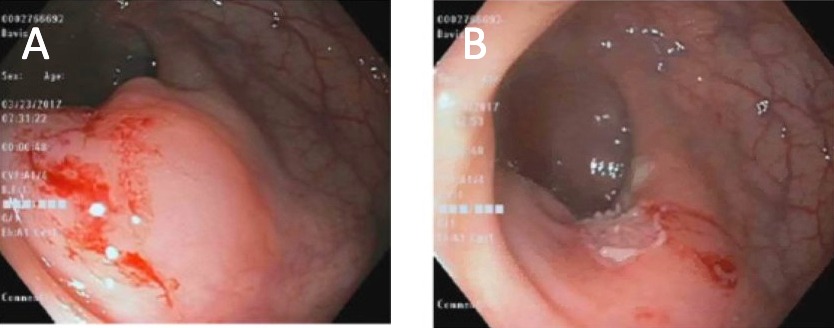Back


Poster Session A - Sunday Afternoon
Category: Colon
A0154 - It’s a Bird! It’s a Plane! No, It Is Endometriosis of the Bowel!
Sunday, October 23, 2022
5:00 PM – 7:00 PM ET
Location: Crown Ballroom

Has Audio

Shadi Saboori, MD, MPH
Atrium Health Carolinas Medical Center
Charlotte, NC
Presenting Author(s)
Shadi Saboori, MD, MPH1, Andrew Dries, MD2
1Atrium Health Carolinas Medical Center, Charlotte, NC; 2Atrium Health, Charlotte, NC
Introduction: Endometriosis affects approximately 10-15% of women of reproductive age and is associated with chronic pelvic pain and infertility though symptoms of intermenstrual bleeding, dysmenorrhea, dyspareunia, and dysuria can be experienced. The most affected extragenital location is the bowel. Bowel endometriosis (BE) is present among an estimated 12 to 37% of women with known endometriosis with 90% found in the rectum or sigmoid. Symptoms of BE include alterations in bowel habits including constipation, diarrhea, dyschezia, tenesmus, and rectal bleeding.
Case Description/Methods: We discuss a 50-year-old female with a history of ongoing menorrhagia presumed from fibroids despite uterine artery embolization with comorbid conditions including obesity, migraines, and depression referred by her PCP in 2017 for first colon cancer screening.
Colonoscopy findings were notable for a 2 cm region of polypoid appearing tissue flat with central retraction observed at the distal rectal fold. The tissue was resected with endoscopic mucosal resection technique (see image). Pathology revealed colonic mucosa with endometriosis.
As a result of her endoscopic findings, she was diagnosed with endometriosis. She was trialed on oral contraceptives which did not improve her menorrhagia. She was seen in clinic for follow-up in 2022 and stated that her symptoms had resolved post menopause.
Discussion: We use this case to highlight BE and discuss the importance of including this underdiagnosed disease process in the differential diagnosis among women of reproductive age presenting to gastroenterology clinics. Symptoms of BE can mimic other gastrointestinal (GI) diseases such as inflammatory bowel disease or irritable bowel disease. Due to symptomatic overlap between BE and other GI disorders, it is often misdiagnosed leading to unnecessary workup and treatments. Any pelvic symptoms that appear cyclic in nature should raise the index of suspicion, and patients should be referred to gynecology for transvaginal ultrasound. If ultrasound is suspicious for BE, further work-up includes barium enema and magnetic resonance imaging to assess the severity and extent of disease. Our case is atypical in that colonoscopy is not sensitive in the diagnosis of BE as lesions are typically extrinsic to the bowel. Should medical therapy be initially pursued among women who are not seeking to conceive over surgical resection, colonoscopy should be undertaken to rule out malignant tumors prior to starting medical therapy.

Disclosures:
Shadi Saboori, MD, MPH1, Andrew Dries, MD2. A0154 - It’s a Bird! It’s a Plane! No, It Is Endometriosis of the Bowel!, ACG 2022 Annual Scientific Meeting Abstracts. Charlotte, NC: American College of Gastroenterology.
1Atrium Health Carolinas Medical Center, Charlotte, NC; 2Atrium Health, Charlotte, NC
Introduction: Endometriosis affects approximately 10-15% of women of reproductive age and is associated with chronic pelvic pain and infertility though symptoms of intermenstrual bleeding, dysmenorrhea, dyspareunia, and dysuria can be experienced. The most affected extragenital location is the bowel. Bowel endometriosis (BE) is present among an estimated 12 to 37% of women with known endometriosis with 90% found in the rectum or sigmoid. Symptoms of BE include alterations in bowel habits including constipation, diarrhea, dyschezia, tenesmus, and rectal bleeding.
Case Description/Methods: We discuss a 50-year-old female with a history of ongoing menorrhagia presumed from fibroids despite uterine artery embolization with comorbid conditions including obesity, migraines, and depression referred by her PCP in 2017 for first colon cancer screening.
Colonoscopy findings were notable for a 2 cm region of polypoid appearing tissue flat with central retraction observed at the distal rectal fold. The tissue was resected with endoscopic mucosal resection technique (see image). Pathology revealed colonic mucosa with endometriosis.
As a result of her endoscopic findings, she was diagnosed with endometriosis. She was trialed on oral contraceptives which did not improve her menorrhagia. She was seen in clinic for follow-up in 2022 and stated that her symptoms had resolved post menopause.
Discussion: We use this case to highlight BE and discuss the importance of including this underdiagnosed disease process in the differential diagnosis among women of reproductive age presenting to gastroenterology clinics. Symptoms of BE can mimic other gastrointestinal (GI) diseases such as inflammatory bowel disease or irritable bowel disease. Due to symptomatic overlap between BE and other GI disorders, it is often misdiagnosed leading to unnecessary workup and treatments. Any pelvic symptoms that appear cyclic in nature should raise the index of suspicion, and patients should be referred to gynecology for transvaginal ultrasound. If ultrasound is suspicious for BE, further work-up includes barium enema and magnetic resonance imaging to assess the severity and extent of disease. Our case is atypical in that colonoscopy is not sensitive in the diagnosis of BE as lesions are typically extrinsic to the bowel. Should medical therapy be initially pursued among women who are not seeking to conceive over surgical resection, colonoscopy should be undertaken to rule out malignant tumors prior to starting medical therapy.

Figure: A: 2 cm polypoid tissue in distal rectal fold B: Endoscopic mucosal resection of lesion
Disclosures:
Shadi Saboori indicated no relevant financial relationships.
Andrew Dries indicated no relevant financial relationships.
Shadi Saboori, MD, MPH1, Andrew Dries, MD2. A0154 - It’s a Bird! It’s a Plane! No, It Is Endometriosis of the Bowel!, ACG 2022 Annual Scientific Meeting Abstracts. Charlotte, NC: American College of Gastroenterology.

